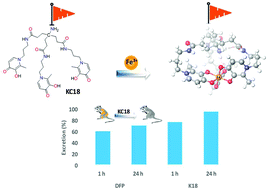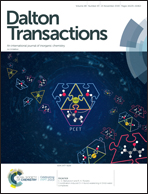New strong extrafunctionalizable tris(3,4-HP) and bis(3,4-HP) metal sequestering agents: synthesis, solution and in vivo metal chelation†
Abstract
Finding new multifunctional metal binders to be potentially used in diagnosis or therapy has been a subject of major challenge. Hydroxypyridinones have long been recognized as privileged chelating structures for the design of metal chelating drugs, especially towards hard metal ions, in view of their decorporation in metal overload disorders. Thus, pursuing our strategy of engineering new polydentate 3-hydroxy-4-pyridinones (3,4-HP) with extrafunctionalization capacity for sensing or targeting purposes, we report herein the synthesis and full characterization of a hexadentate (tris-3,4-HP) and a tetradentate (bis-3,4-HP) ligand, possessing three and two 3,4-HP arms N-attached to an aminomethanetrispropionic acid backbone, respectively. Thus, as compared with previously reported analogues, each ligand possesses an extra free amino group ready for further functionalization. Their chelating capacity towards Fe and Al was evaluated in aqueous solution, by potentiometric and spectroscopic techniques, and they proved to be strong sequestering agents for these metal ions without depletion of Zn, an essential biometal. Their excellent in vivo metal-decorporation capacity was also evidenced in mice injected with a radiotracer (67Ga) as an animal model of metal overload pathological situations. These findings provide encouragement for further ongoing extrafunctionalizations in view of several potential biomedical applications.



 Please wait while we load your content...
Please wait while we load your content...